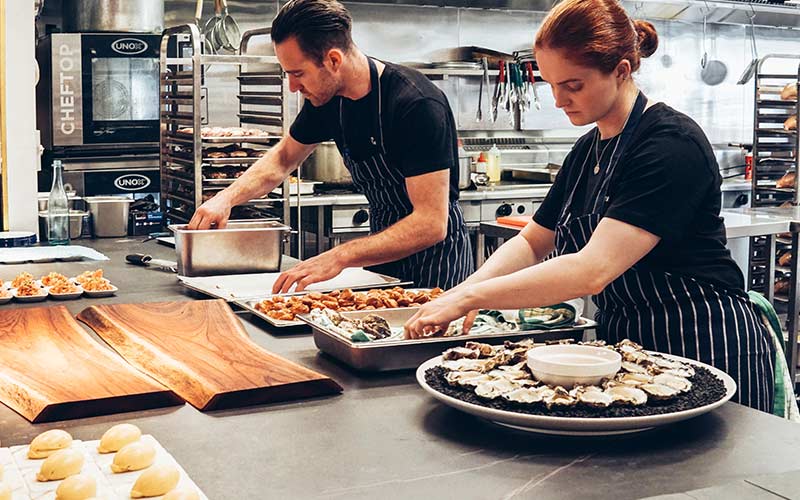
Globally, food allergy cases have risen by up to 50% in the past decade, with a 700% rise in hospitalisations due to anaphylaxis.
For restaurant owners, this statistic is shocking and means staff need to be increasingly vigilant when it comes to preparing and cooking food.
Food allergies can be severe and potentially life-threatening. While it is the individual’s responsibility to manage their allergy, restaurants have a duty of care to their guests and must do everything in their power to reduce the risk of customers suffering an allergic reaction.
In this guide, we’ll cover everything from the most common food allergies in Australia to best practice tips for managing food allergies in your restaurant.
Let’s dive in.
- Most common food allergies in Australia
- Food allergies: front of house best practice tips
- Food allergies: back of house procedures
- What to do if a customer has an allergic reaction
Most common food allergies in Australia
Approximately 2% of adults in Australia suffer from a food allergy. This rises to 4-8% of children under the age of five and 10% of babies under 12 months old. While each individual’s allergy can vary in severity, some can be life-threatening and should always be taken seriously.
The following ten foods account for approximately 90% of all food allergies:
- Wheat – commonly found in bread, cereals, pasta, pastries, cakes and pizzas. It’s estimated that 0.21% of people suffer from a wheat allergy – that’s more than 53,000 Australians.
- Peanuts – commonly found in chocolate, baked goods, cereals and ice creams. It’s estimated that 0.5% of people are allergic to peanuts – that’s more than 125,000 Australians.
- Tree nuts – commonly found in baked goods, chocolate, ice cream, cereals, veggie burgers and sauces. It’s estimated that between 0.1% – 4.9% of people have a tree nut allergy.
- Shellfish – such as oysters, octopus, squid, muscles, lobster, crab, crayfish and prawns. It’s estimated that 3% of people suffer from a shellfish allergy. That’s over 750,000 Aussies.
- Eggs – commonly found in baked goods, custards, ice cream, marshmallows, pasta and mayonnaise. It’s estimated that 0.5 – 2.5% of young children and 0.2% of adults are allergic to eggs.
- Milk – commonly found in butter, cheese, cream, custard, yoghurt, ice cream, baked goods, and chocolate. It’s estimated that 2% of infants and 0.5% of adults have a cow’s milk allergy.
- Fish – commonly found in stocks and dressings, barbecue sauce, bouillabaisse, caesar dressing and Worcestershire sauce. It’s estimated that 0.2% of people are allergic to fish.
- Soy – commonly found in miso, soy sauce, teriyaki sauce and tofu. It’s estimated that 0.27% of people are allergic to soybeans.
- Sesame seeds – commonly found in bagels, bread, breadsticks, hamburger buns and rolls, cereals, falafel, hummus flavoured rice and noodles, margarine and vegetarian burgers. It’s estimated 0.2% of people have a sesame seed allergy – that’s more than 51,000 Australians.
- Lupin – common foods that contain lupin include pasta, chocolate spreads, vegetarian sausage, sauces, stews, baked onion rings, salads, lupin hummus spreads, ice creams, bread, rolls, biscuits and baked goods.
Sign up to free online food allergy training, to ensure your staff are well trained on common allergens, alternative names for allergens, common foods that contain allergens and how to manage customers with a food allergy.

Food allergies: front of house best practice tips
While it is the responsibility of individuals to disclose their food allergies, restaurants also have an obligation to follow robust allergen management practices. Restaurants must also ensure their staff are trained on potential allergens and can inform customers accordingly.
Consider these front-of-house tips for managing food allergies in your restaurant, and ensure your front-of-house team are well trained on common allergens, allergic reaction symptoms and the ingredients in each of your menu items.
State allergen advice on your menu
While it isn’t a legal requirement to list all allergy advice on your menu, it’s a good idea to note some of the main allergy-prone ingredients next to any dishes that may contain them.
This can be done with indicator symbols next to each dish – similar to adding a (V) or (Vg) next to vegetarian and vegan meals. Some other options include (GF) next to gluten-free dishes and a nut symbol next to any dishes that contain nuts.
You could also add an allergy statement to your menu, for example:
“Allergy Warning: Menu items may contain or come into contact with wheat, eggs, nuts and milk. Ask our staff for more information.”
Create a detailed ingredients list for each of your dishes
Write up a detailed list of ingredients for each of your menu items. You can then hand this out to any customers who say they have food allergies.
Remember to include any ingredients in pre-prepared or pre-packaged products as well. For example, barbecue sauce often contains traces of tree nuts, and mayonnaise contains eggs.
You should also include a note on your ingredients list that explains how you cannot always guarantee allergen-free food, as your restaurant kitchen is not completely free of allergens.
Know the signs of an allergic reaction
No matter how carefully your team prepares a customer’s food, allergic reactions can still occur. Therefore it’s crucial for staff to recognise the signs of an allergic reaction.
An allergic reaction can involve any or all of the following symptoms:
- Swelling of the face or lips
- Breaking out in hives or welts
- Swelling of the tongue or throat
- Difficulty breathing or talking
- Wheezing or coughing
- Loss of consciousness or vomiting
Clear lines of communication
To minimise the risk of guests having an allergic reaction, it’s imperative for front-of-house and back-of-house staff to have impeccable communication.
It’s important to have a robust procedure in place, so staff are aware of their responsibilities when a customer says they have an allergy. This could include having a clear process for marking orders with allergy advice and for kitchen staff to alert servers when certain ingredients change.
It’s also a good idea to provide training for all of your staff (and regular refresher sessions) so they know exactly what to do, and who to communicate to if a customer has a food allergy.

Take customer allergy requests seriously
This should go without saying, but it’s crucial for your staff to take all allergy requests seriously.
Everyone in your restaurant, from wait staff through to kitchen staff need to be aware of the risks of food allergies and be clear on how to manage food allergy requests from customers.
Let your front of house team know it’s ok to ask questions – the more details they can get from the customer about their allergy, the better the kitchen can prepare their meal.
Food allergies: back of house procedures
Ensure your back-of-house team receive detailed allergy training and consider these tips to minimise the risk of allergic reactions.
Know your ingredients
While this might seem obvious, kitchen staff must have a deep understanding of all the ingredients in the meals they prepare – including pre-prepared items such as sauces and cooking oils.
Ask your suppliers to provide product information and allergy advice for all stock and ingredients you purchase from them. And, every time you change suppliers or purchase new products ensure this information is re-supplied and up to date.
Back of house staff must also advise front of house staff and customers about what menu items to avoid if a certain allergy is highlighted. Keep a list of all ingredients and allergens for your menu items in an easily accessible location, so all staff can access the information when needed.
Avoid cross-contamination
When an order comes through to the kitchen for a patient with allergies, it’s crucial for kitchen staff to follow a rigorous preparation and cooking process to avoid cross-contamination.
To reduce the risk of cross-contamination, kitchen staff must:
- Frequently and thoroughly wash their hands
- Clean and sanitise equipment and utensils after they touch different types of food
- Ensure food is stored correctly and away from cooking stations
- Food products and ingredients are clearly labelled
- Prepare allergen-free meals separately, using a dedicated area and equipment

How to prepare food for a customer with a food allergy
When an order comes through with an allergy request, your kitchen staff should follow a strict procedure to minimise the risk of an allergen contaminating the requested meal.
Consider the following steps when preparing food for a customer with a food allergy:
- Notify all kitchen staff that an allergen-free meal is being prepared, and ensure staff are aware of the precise allergy e.g. dairy, peanut, fish etc.
- Avoid cross-contamination by following the steps above.
- Ensure all equipment being used to prepare the dish are clean
- Don’t substitute ingredients unless you’re absolutely sure the new ingredients don’t contain the allergen.
- Clearly identify the allergen-free meal, so front of house staff are aware and can bring the dish to the table separately from other dishes – to further reduce the risk of cross-contamination.
What to do if a customer has an allergic reaction
Allergic reactions can happen rapidly and customers can go into anaphylactic shock – which requires urgent medical attention.
If a customer at your restaurant has an allergic reaction, it’s important to act as quickly as possible.
- Dial 000 and request an ambulance
- If the customer has an adrenaline autoinjector e.g. EpiPen, this must be administered immediately.
- Don’t allow the customer to stand or walk, until medical help has arrived
- If the customer is having difficulty breathing, lie them flat on the floor, or sit them down on the floor with their legs outstretched infront of them.
Food allergies can seriously impact people’s health and should always be taken seriously by restaurant staff. An allergic reaction can be life-threatening and can seriously impact a restaurant’s reputation. Therefore, it’s important to regularly train your staff on common food allergies, the ingredients and possible allergens in your dishes and how to spot an allergic reaction.

News you care about. Tips you can use.
Everything your business needs to grow, delivered straight to your inbox.


